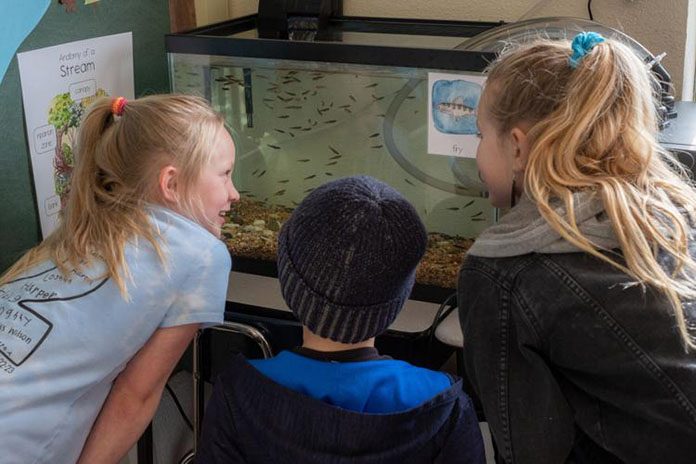
“Eggs to fry,” might make you think about a hearty breakfast, but to a third grade teacher at Hermiston’s Highland Hills Elementary School and her young scholars the phrase means how you start with a couple hundred donated rainbow trout eggs, hatch them, watch the little hatchlings grow and finally release them into the wild as “fry.”
Teacher Taylor Verwold said the idea came from when she was student teaching in St. Paul.
“My cooperating teacher was doing the project in her room,” she said. “But she was having chinook salmon. It’s a program through the Oregon Department of Fish and Wildlife, their Salmon and Trout Enhancement Program.”
The enhancement part of the equation also seems to be shared with the elementary students. The range of grades at Highland Hills Elementary is K-5, and probably every one of these students has trooped through Verwold’s classroom at least once during the past few weeks to see the developing rainbow trout in the corner aquarium.
The eggs came in a box from the Wizard Falls Hatchery in Camp Sherman, she said, and the class releases them Thursday, Feb. 29.
Verwold said all three third grade classrooms will take the tiny trout to nearby Hat Rock State Park on to release them into the pond there, which ODFW stocks with rainbow trout.
Fish rearing no problem
She said raising the fish in the classroom was easy.
“We really didn’t have to do much,” Verwold said. “They’re in a climate-controlled tank where they stay between 48 to 52 degrees.”
The tank cooler is about the size of a desktop computer. ODFW provides everything a classroom needs to hatch and develop their own trout or salmon eggs, plus all the equipment.
“I just had to apply for it,” Verwold said. “When I was student teaching two years ago I loved it, which was why I wanted to seek out this program. I feel it’s really beneficial for students to get connected with wildlife, learn some science standards, English language arts and math standards along the way.”
Marty Olson at ODFW works in the Salmon and Trout Enhancement Program.
“We’ve been running the program probably since the early 1990s,” Olson said. “It’s a bit hard to say how many schools use it because it fluctuates a little bit, but we have 650-700 schools that participate.”
Olson said she doesn’t believe classrooms that release a couple hundred small fry do much to restock the state’s fish population.
“The educational component of the program, that’s where we see the returns,” she said.
What students learn
Verwold said the program teaches students about conservation, the Oregon Department of Fish and Wildlife, water resources in the community and the wildlife habitats around Hermiston.
Students made a large mural that covers a swath of whiteboard in Verwold’s classroom. It shows the life cycle of trout, and some of the hazards they can face after release from the cozy corner fish tank into the wild bodies of water.
Verwold said her students learn primarily about the trout life cycle.
“We’ve been following from eggs to alevins to fry,” Verwold said. “Then some rainbow trout will actually go through a process called smoltification in which they are able to adapt to living in salt water, and when they do that process, they’re called steelhead trout.”
Life for a small fish in the wild is dangerous. The hazards depicted on the big classroom mural detail some of these.
“We’ve learned what predators may be an issue,” Verwold said. “The storyboard we’ve made shows houses, factories and neighborhoods, which are things that could potentially harm fish, not just rainbow trout. But you think about salmon, and how pollution can affect them, or there are bears that might eat them. So the students learn about threats and what we can do to conserve their populations.”
Students take in the trout
Harper Headley, a 9-year-old in Verwold’s class, said she liked having the trout.
“They’re fun to have,” she said. “There’s a lot of attention from other classes.”
Audrey Baker, 9, third grader from another class, said it was fun to see how they grow.
Beau Greenough, 9, another third grader, said he a regular.
“I come every Friday and take a look at them and we talk about the fish,” he said.
He and Audrey said they did not anticipate missing the fish after they are gone, but Harper said she would.
“Yes, because it was really great having them around,” she said, “and they were fun to look at.”








